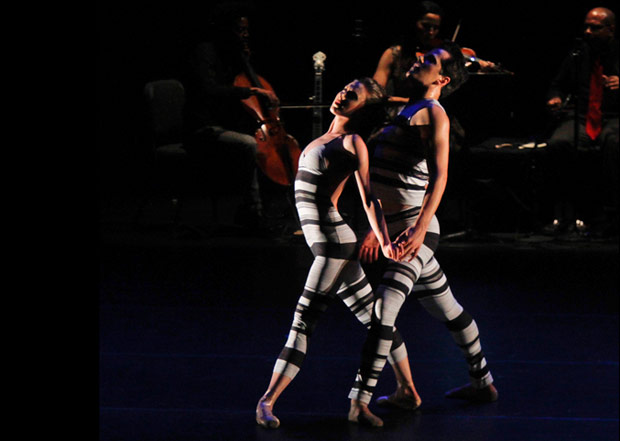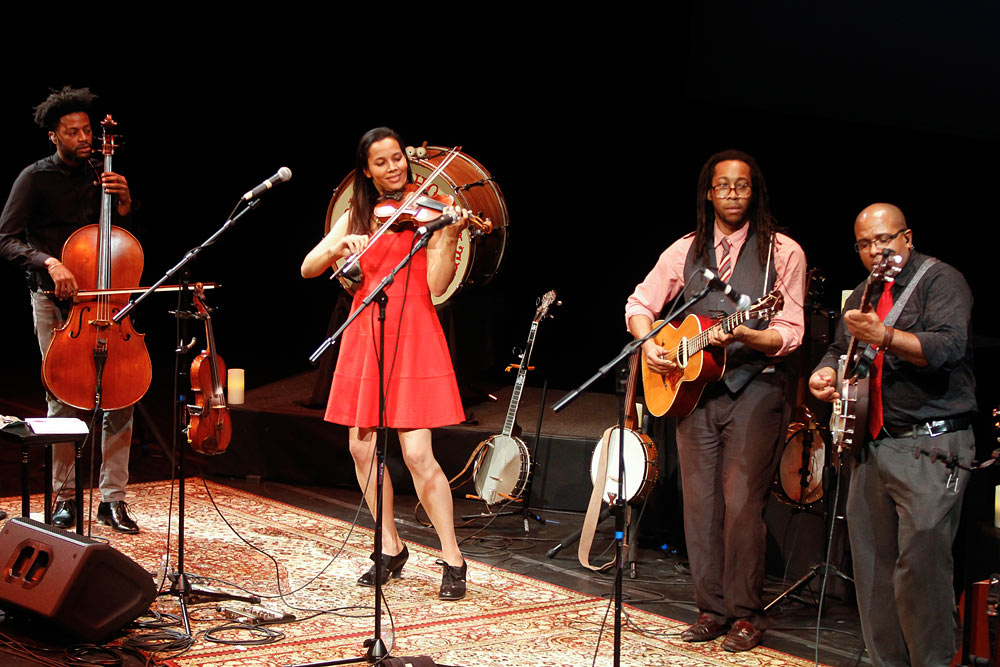
© Rahav Segev. (Click image for larger version)
Twyla Tharp Countrified
www.twylatharp.org
www.carolinachocolatedrops.com
New York, Brooklyn Academy of Music
10 April 2014
Twyla Tharp loves Americana. She’s made dances to Shaker hymns and to the crooning voice of Frank Sinatra, and whipped up steps to the super-sophisticated piano tunes of Willie “The Lion” Smith. So it’s no surprise that she should take a shine to the old-time African-American string-band style of the Carolina Chocolate Drops, a young group out of North Carolina that has been taking the folk scene by storm since its first album, Heritage, from 2006. Tharp’s new dance, “Cornbread Duet,” is set to songs from two of the group’s most recent albums, “Genuine Negro Jig” (2010) and “Leaving Eden” (2012). It was performed at the Carolina Chocolate Drops’ one-night appearance at the Brooklyn Academy of Music on April 10.
The band has gone through various line ups since its founding almost a decade ago. It’s now led by the smart and beautiful Rhiannon Giddens, the only remaining original member. She sings, plays the fiddle – in a traditional short-bowing style – as well as the banjo, and has been known to write her own songs, like “Country Girl,” a paean to all things southern. Most of the band’s repertoire, though, consists of traditional tunes written by African-American musicians from the Piedmont area in the late nineteenth and early twentieth century.

© Rahav Segev. (Click image for larger version)
The Chocolate Drops’ first teacher was Joe Thompson, a fiddler who learned to play from his father, who was in turn taught by his own father, a slave. (Thompson died in 2012, at the age of 93.) The violin was an imported European instrument. As the recent movie “Twelve Years a Slave” grotesquely illustrates, some of the plantation owners taught their slaves to play, so they could entertain the neighbors at local dances. The banjo, however, was an African American instrument, a descendant of the West-African akonting. Somewhere along the way the two instruments came together, along with the jug, “bones” (hand percussion), and sometimes the kazoo, and voilà, the string band was born.
The traditional songs from Piedmont have strong rhythms and infectious tunes with plainspoken lyrics, often laced with double-entendres. They’re great for dancing. In fact, it was through dancing that Giddens discovered the music in the first place: “I was really into contradancing,” a kind of social dance similar to square dancing but organized in long lines rather than quadrilles. “After college, I became a dance gypsy, going to all the dances in the area, and that’s how I got into the folk world.”

© Rahav Segev. (Click image for larger version)
A couple of years ago Nonesuch, the Drops’ label, sent a couple of their albums to Twyla Tharp, who, by all accounts fell in love. She picked five songs, and the idea for a dance suite was born. Meanwhile, Tharp had met the dancers she wanted to work with, Tiler Peck and Robert Fairchild of New York City Ballet. Both are strong technicians – Peck is a genuine phenomenon – and started out in jazz dance. At eleven, Peck performed in a Susan Stroman production of “The Music Man” on Broadway. Fairchild, known by everyone as “Robbie,” was obsessed with Gene Kelly as a kid. The two have the right mix of honest, all-American song-and-dance chops and perfectionism that Tharp’s choreography demands. Her dances are relentlessly fast and super-intricate, filled with changes of direction and tricky combinations of steps, not for the faint of heart. (Peck’s part was on pointe.) At the same time, Tharp wants it all to look easy, thrown off, which of course makes everything twice as difficult. Last year, working on another piece with American Ballet Theatre, she said to the dancers, without a hint of humor, “remember, you’re superhuman.”
Carolina Chocolate Drops performing Cornbread and Butterbeans
The first song Peck and Fairchild danced to was “Cornbread and Butterbeans,” an irresistible ditty about hard work and the simple joys in life: “Cornbread and butterbeans and you across the table, eatin’ beans and makin’ love as long as I am able. Growin’ corn and cotton too and when the day is over, ride the mule and cut the fool and love again all over.” For this passage, Tharp invented a folksy, up-beat, hoedown-like duet. (The costumes, which feature a bold black-and-white print, are by Norma Kamali, a favorite of Tharp’s.) Then there’s a soft shoe for Fairchild, set to “Read ‘em John,” an acapella call-and-response composition in a South Carolinian style known as a “ring shout” (video). According to one interpretation, the “John” mentioned in the lyrics alludes to literate slaves who read documents for others on the plantation.
Then, Peck danced a fast-paced solo, filled, according to Fairchild, with “every step you can possibly put into a dance.” It is set to a hard-driving banjo-and-bones tune, “Ruby, are you Mad at Your Man?” sung by Giddens in her focused, subtly-inflected voice. Giddens is a former opera major from Oberlin who used to sing coloratura roles like Juliette in Gounod’s “Roméo et Juliette” and Fiordiligi in Mozart’s “Così Fan Tutte.” Her training has given her voice a striking suppleness, control, and range of colors. She shapes and modulates every word very precisely, for maximum effect. “Ruby” is an angry song, and she sings the hell out of it.
Then comes a slow, sultry duet to an instrumental number, “Snowden’s Jig,” for which Tharp’s sole instruction to the dancers was that they should imagine themselves dancing in a hot room, as hot as a hot summer night in the South. “It’s like dancing underwater,” Peck says. This leads directly into a show-stopping finale, “Sandy Boys.” Thirteen minutes of non-stop dancing.

Rhiannon Giddens, Rowan Corbett, Hubby Jenkins, Twyla Tharp, Tiler Peck and Robert Fairchild.
© Rahav Segev. (Click image for larger version)
Four days before their BAM appearance, Peck and Fairchild were looking excited and not terribly flustered about the fact they would only have a single rehearsal with the band, on the morning of the show, between two New York City Ballet rehearsals. Fairchild’s left calf was feeling a bit wonky after a week of performances at the Kennedy Center. But they were chatty and upbeat, repeatedly finishing each other’s sentences, almost like newlyweds. Which they will soon be. They’ll be tying the knot following the end of City Ballet’s spring season, at the High Line Hotel. After which, in the fall, Peck will star in a new musical inspired by Degas, The Little Dancer, composed by Stephen Flaherty and directed by Susan Stroman. Fairchild, in turn, will go off to rehearse a new Broadway production of An American in Paris, directed and choreographed by Christopher Wheeldon. He’ll be dancing Gene Kelly’s role. After the Cornbread Duet, that should be a piece of cake.

















You must be logged in to post a comment.